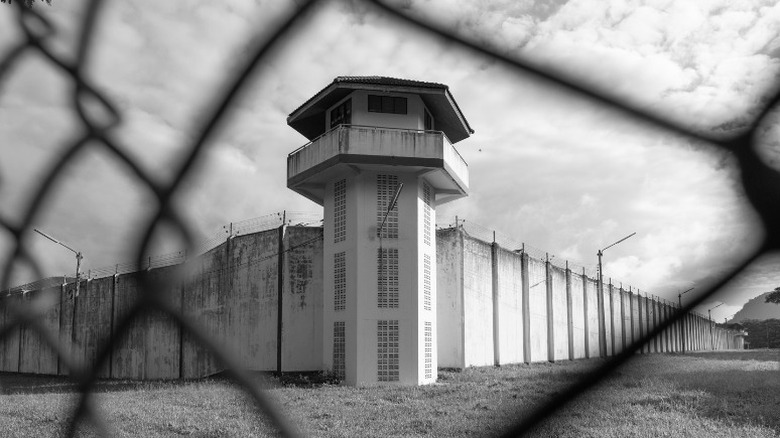How Many Victims Did 'The Trash Bag Killer' Patrick Kearney Really Have?
If you're a true-crime junkie, you probably noticed that an abundance of serial killers were active in the state of California during the 1970s and '80s. From the Golden State Killer to the Hillside Strangler to the notorious Night Stalker, no one out west seemed to be safe from someone's murder spree.
But somewhere between the rise of Charles Manson and the arrest of Richard Ramirez were a lengthy series of brutal murders that resulted in scores of bodies being dumped near California's extensive system of highways. These "freeway killings" were attributed to three separate men, who terrorized the citizens of the Golden State unbeknownst to one another.
One of the three freeway killers was a man who was also known as "The Trash Bag Killer." He earned this nickname due to his chosen method of disposing of his victims' corpses in sturdy contractor trash bags, which he deposited on the roadside, per Oxygen. His name was Patrick Kearney, and he amassed quite a tally of murder victims until he was finally captured in 1977.
An M.O. revealed
Patrick Kearney was a killer with a double life. Those who knew him before he was arrested thought him to be normal and unassuming (via Oxygen). He lived with his boyfriend David Hill in Redondo Beach, whom he had met while stationed with the Air Force in Texas (via Murderpedia). Even though Hill was married when the two men met in 1962, he left his wife and moved to California to be with Kearney in 1966.
Kearney was already a killer before he and Hill began cohabitating. Kearney claimed his first victim in 1962, an unidentified male hitchhiker. Over the next decade, he rarely killed, having only three additional murders attributed to him. But in 1971, Kearney went on a spree that netted him over two dozen more victims.
His M.O. was finding men at gay bars and luring them away for sex, though several of Kearney's victims were hitchhikers that he picked up. While many of his murders were committed via suffocation, the vast majority were completed by shooting his mark in the back of the head. And most were disposed of in trash bags along California highways.
It was later revealed that most of Kearney's murders would occur immediately after he and Hill would get into arguments. Kearney would storm off and purportedly take his frustration and anger out on those who were unfortunate enough to be picked up by him.
The murder of John LeMay
Patrick Kearney's streak came to an end with the murder of John LaMay. When LaMay disappeared in March 1977, neighbors told investigators that he was last seen on his way to visit David Hill. Rather than Hill, LeMay was greeted by Kearney, who invited him inside. Before Hill arrived home, Kearney shot LaMay while the two of them were watching television together. Kearney then dismembered LaMay's body, placed it in trash bags, and dumped the remains in the desert (via Murderpedia).
Police questioned both Hill and Kearney about LaMay's whereabouts as soon as a missing person report was filed. Initially, investigators weren't suspicious of the couple at all. But when LaMay's body was discovered four days later, police had a renewed interest in Hill and Kearney. But before they could detain them for additional questioning, Kearney and Hill fled to Texas. According to The Gadsen Times, it was at the insistence of their families that the couple return to California and turn themselves in.
Convicted of 21 murders
Soon after Kearney was arrested, he was faced with a growing amount of evidence against him. Investigators had been putting together a strong case that tied in the murder of LaMay with the unsolved murders of other males that had been killed and disposed of in the same manner. He agreed to plead guilty to the two murder charges that he was immediately facing, and offered a written confession to his other crimes. Kearney reached a deal with prosecutors, who assured him that they would not pursue the death penalty in exchange for both his confession and his guilty pleas on all counts. While initially thought of as an accomplice, Hill was released without any charges filed against him.
In his written confession, Kearney claimed responsibility for the murders of 28 people. He pled guilty in court to three of the murders on December 21, 1977 (via Just Criminals). The following February, prosecutors presented charges for an additional 21 murders, to which Kearney also entered the agreed-upon guilty pleas. According to Murderpedia, prosecutors believed Kearney had killed seven more victims, but couldn't get enough evidence from his confession to build a case for additional charges. Satisfied that a total of 21 consecutive life sentences was enough to keep Kearney behind bars for the rest of his life, they ended their investigation.
Kearney, now age 82, is currently incarcerated at Mule Creek State Prison for men in Ione, California.



